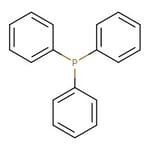Search Thermo Fisher Scientific
Thermo Scientific Chemicals
Triphénylphosphine, poudre, 99 %, Thermo Scientific Chemicals
Référence: L02502.30
250 g, Each



Thermo Scientific Chemicals
Triphénylphosphine, poudre, 99 %, Thermo Scientific Chemicals
Référence: L02502.30
250 g, Each
Quantité
Référence: L02502.30
également connu sous le numéro L02502-30
Prix (EUR)
43,92 Prix en ligne
48,80
Each
Quantité
-
Identifiants chimiques
CAS
603-35-0
IUPAC Name
triphenylphosphane
Molecular Formula
C18H15P
InChI Key
RIOQSEWOXXDEQQ-UHFFFAOYSA-N
SMILES
C1=CC=C(C=C1)P(C1=CC=CC=C1)C1=CC=CC=C1
Spécifications
Appearance (Color)
White to pale cream
Assay (GC)
≥98.5%
Identification (FTIR)
Conforms
Form
Powder or crystalline powder
Melting Point (clear melt)
79-83°C
Description
Triphenylphosphine is used in the synthesis of organic compounds due to its nucleophilicity and its reducing character. It is involved in the synthesis of biaryl compounds, phosphonium salts and other phosphorus compounds. As a reducing agent, it is used to prepare aromatic amines from the corresponding aromatic N-oxides. The anionic phosphine is usually isolated as the trisodium salt, which reacts with rhodium to form a complex that finds use in industrial hydroformylation reactions. It is also used to prepare Wilkinson's catalyst, RhCl(PPh3)3 useful to catalyze the hydrogenation of alkenes and tetrakis(triphenylphosphine)palladium(0) that is widely used to catalyse C-C coupling reactions in organic synthesis.
This Thermo Scientific Chemicals brand product was originally part of the Alfa Aesar product portfolio. Some documentation and label information may refer to the legacy brand. The original Alfa Aesar product / item code or SKU reference has not changed as a part of the brand transition to Thermo Scientific Chemicals.
Applications
La triphénylphosphine est utilisée dans la synthèse de composés organiques en raison de son pouvoir nucléophile et de son caractère de réduction. Il est impliqué dans la synthèse de composés biaryl, de sels de phosphonium et d’autres composés du phosphore. En tant qu’agent réducteur, il est utilisé pour préparer des amines aromatiques à partir des N-oxydes aromatiques correspondants. La phosphine anionique est généralement isolée comme le sel trisodique, qui réagit avec le rhodium pour former un complexe qui trouve son application dans les réactions d’hydroformylation industrielles. Il est également utilisé pour préparer le catalyseur Wilkinson′s, RhCl(PPh3)3 utile pour catalyser l’hydrogénation des alcènes et du tétrakis(triphénylphosphine)palladium(0) qui est largement utilisé pour catalyser les réactions de couplage de liaisons C-C dans la synthèse organique.
Solubilité
Soluble dans l’éther, le benzène, le tétrachlorure de carbone, l’acide acétique glacial, l’acétone, le chloroforme et l’alcool. Insoluble dans l’eau.
Remarques
Incompatible avec les agents oxydants et les acides.
La triphénylphosphine est utilisée dans la synthèse de composés organiques en raison de son pouvoir nucléophile et de son caractère de réduction. Il est impliqué dans la synthèse de composés biaryl, de sels de phosphonium et d’autres composés du phosphore. En tant qu’agent réducteur, il est utilisé pour préparer des amines aromatiques à partir des N-oxydes aromatiques correspondants. La phosphine anionique est généralement isolée comme le sel trisodique, qui réagit avec le rhodium pour former un complexe qui trouve son application dans les réactions d’hydroformylation industrielles. Il est également utilisé pour préparer le catalyseur Wilkinson′s, RhCl(PPh3)3 utile pour catalyser l’hydrogénation des alcènes et du tétrakis(triphénylphosphine)palladium(0) qui est largement utilisé pour catalyser les réactions de couplage de liaisons C-C dans la synthèse organique.
Solubilité
Soluble dans l’éther, le benzène, le tétrachlorure de carbone, l’acide acétique glacial, l’acétone, le chloroforme et l’alcool. Insoluble dans l’eau.
Remarques
Incompatible avec les agents oxydants et les acides.
RUO – Research Use Only
Figures
Documentation et téléchargements
Certificats
Recherchez par numéro de lot ou numéro de lot partiel
Foire aux questions (FAQ)
Citations et références
Search citations by name, author, journal title or abstract text
Sécurité et manipulation
Classification of the substance or mixture
CLP classification - Regulation(EC) No 1272/2008
Acute oral toxicity
Category 4
Skin Sensitization
Category 1
Specific target organ toxicity - (repeated exposure)
Category 2
Label Elements
Signal Word
Warning
Hazard Statements
H302 - Harmful if swallowed
H317 - May cause an allergic skin reaction
H373 - May cause damage to organs through prolonged or repeated exposure
Precautionary Statements
P301 + P312 - IF SWALLOWED: Call a POISON CENTER or doctor/physician if you feel unwell
P280 - Wear eye protection/ face protection